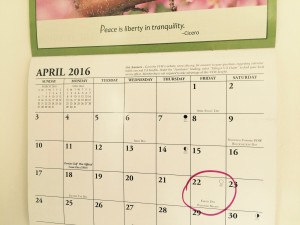 Passover 2016 begins on April 22.
Passover 2016 begins on April 22.
A remembering break is just as necessary for national and spiritual health as a break from work is for mental and physical health. Of the seven holidays included in the Israelite covenant law, three were not optional. They marked events in Israelite salvation history that God did not want his people to forget.
All were harvest celebrations, and each festival was also a reality check—a time to rejoice after an abundant harvest or pray for a better harvest after a lean year. Either way the Israelites acknowledged dependence on Yahweh God and thanked him for his blessings as they celebrated year after year.
The nations who worshipped fertility gods also had festivals based on their agricultural year, but the biblical holidays were vastly different. Instead of trying to manipulate the gods through lavish sacrifices in order to ensure wealth, the Israelites were to bring their sacrifices humbly. The whole family feasted on the major portion of the sacrifice, sharing a meal with God.
1. The first feast, Passover, marked the beginning of the barley harvest, the first crop of the agricultural year. Passover was followed by a week-long festival of unleavened (flat, no-yeast) bread. The annual festival fell exactly on the date of their deliverance from slavery in Egypt. As the dark night of the original Passover approached, the people slaughtered a lamb and painted their doorposts and lintels with the blood. They were instructed to roast the lamb and then celebrate a feast of deliverance by faith before it happened. They ate the lamb with bitter herbs, recalling their years of slavery, and unleavened bread because they needed to prepare for a hasty exodus. No time to sit around waiting for bread to rise! That was the night of the tenth and most terrible of all the plagues that fell on Egypt. Every firstborn male in the country would die except those protected by the blood of the Passover lamb. Egyptians as well as Israelites were warned, but the Angel of Death only “passed over” the homes of those who believed and obeyed instructions. In the middle of the night a heart-broken Pharaoh demanded that his slaves leave.
2. Pentecost, the second feast, is the same as the Old Testament Feast of Weeks. It lasted only a single day, but a unique counting system helped build anticipation for it. The first sheaf of barley was cut two days after Passover as part of the Feast of Unleavened Bread. Then the people began counting the days to the wheat harvest. They counted for forty-nine days or seven weeks. Just imagine the children laying out seven rows of seven pebbles, growing more excited by the day as the seven rows became more complete. On the fiftieth day, everyone stopped work for another big feast, bringing the first loaves of wheat bread to the Lord. The word pentecost is based on the Greek word for fifty. In Hebrew, the day is called Shavuot which means “weeks.”
Pentecost recalled the giving of the law at Mount Sinai, which happened fifty days after leaving Egypt. Mount Sinai was lit by flames of fire as the Lord thundered his Covenant Code of Love. The law was a gift intended to shape a nation who would bless all nations on earth by living Yahweh’s law of love: Don’t worship false gods. I am Love. Any other worship leads to greed, pain, and suffering. Love your neighbor as yourself.
3. The Feast of Tabernacles, Succoth in Hebrew (which means booths or shelters) commemorates the journey in the wilderness when the Israelites did not live in permanent houses. It came in the autumn following the grape harvest, the last crop of the year. It is much like our Thanksgiving feast, but it was even better. Imagine Thanksgiving as a weeklong family campout, celebrated year after year—and skipping it for any reason was not an option.
Tabernacles was designed to help the people appreciate life in the Promised Land and remember the long journey to get there. Nothing was allowed to spoil the most exciting, most joyous holiday of the year. The law specifically instructed the people to include the poor, the widows, orphans, aliens, and the Levites who had no land to harvest or herds to supply sacrifices for a Thanksgiving feast. I love the fact that the instructions included a command to rejoice. No matter how long the cooking took, or how far or difficult the journey to Jerusalem, or how many things went wrong while trying to build the family shelter—grumpiness was forbidden!
Few people celebrate those feasts anymore, but remembering our blessings and how God has led us is absolutely essential to our spiritual health.
The Gilgal, a monument of remembering, becomes an important symbol to the characters in the Stones of Gilgal epic novels.
Learn more at www.stonesofgilgal.com